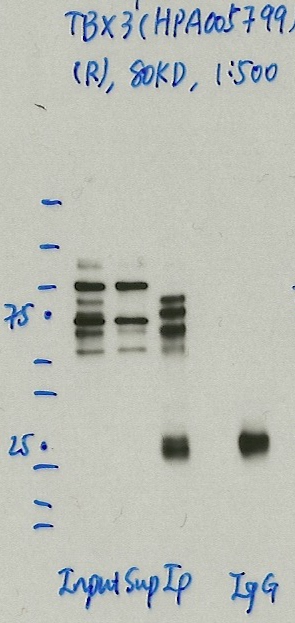ENCAB402UFE
Antibody against Homo sapiens TBX3
Homo sapiens
HepG2
characterized to standards with exemption
- Status
- released
- Source (vendor)
- Sigma
- Product ID
- HPA005799
- Lot ID
- A78565
- Characterized targets
- TBX3 (Homo sapiens)
- Host
- rabbit
- Clonality
- polyclonal
- Purification
- affinity
- Isotype
- IgG
- Antigen description
- T-box transcription factor TBX3 recombinant protein epitope signature tag (PrEST)
- Antigen sequence
- QSMRVFDERHKKENGTSDESSSEQAAFNCFAQASSPAASTVGTSNLKDLCPSEGESDAEAESKEEHGPEACDAAKISTTTSEEPCRDKGSPAVKAHLFAAERPRDSGRLDKASPDSRHSPATISSSTR
- Aliases
- michael-snyder:782
- External resources
Characterizations
TBX3 (Homo sapiens)
HepG2
not compliant
- Caption
- Immunoprecipitation was performed on nuclear extracts from the cell line: HepG2, using the antibody HPA005799. The blot shows western blot analysis of input, flowthrough, immunoprecipitate and mock immunoprecipitate using IgG.
- Reviewer comment
- No major band indicated at >50% of the total signal in IP lane. Multiple bands could be acceptable with a knockdown rescue characterization.
- Submitted by
- Denis Salins
- Lab
- Michael Snyder, Stanford
- Grant
- U54HG006996
TBX3 (Homo sapiens)
HepG2
exempt from standards
- Caption
- Immunoprecipitation was performed on nuclear extracts from the cell line HepG2 using the antibody HPA005799. Lane 1: input nuclear lysate. Lane 2: material immunoprecipitated with antibody. Lane 3: material immunoprecipitated using control IgG. Marked bands were excised from gel and subjected to analysis by mass spectrometry. Target molecular weight: 79.389.
- Submitter comment
- We analyzed multiple immunoreactive bands by mass-spec.
- Reviewer comment
- Multiple bands but mass spec analysis showed the target TF to be highest ranked and not in IgG with no other site specific TFs above the target.
- Submitted by
- Nathaniel Watson
- Lab
- Michael Snyder, Stanford
- Grant
- U54HG006996
- Download
- MS1036_6_TBX3-HPA005799.JPG
TBX3 (Homo sapiens)
Method: immunoprecipitation followed by mass spectrometry
exempt from standards
- Caption
- IP followed by mass spectrometry. Briefly, protein was immunoprecipitated from HepG2 nuclear cell lysates using the antibody HPA005799, and the IP fraction was loaded on a 10% polyacrylamide gel (NuPAGEBis-Tris Gel) and separated with an Invitrogen NuPAGE electrophoresis system. The gel was stained by ColloidialCoomassie G-250 stain, gel fragments corresponding to the bands indicated were excised. Then proteins were trypsinized using the in-gel digestion method. Digested proteins were analyzed on an Orbitrap Elite mass spectrometer (Thermo Scientific) by the nanoLC-ESI-MS/MS technique. Peptides were identified by the SEQUEST algorithm and filtered with a high confidence threshold (Peptide false discovery rate < 1%, 2 unique peptides per protein minimum, mass error < 10 ppm).
- Submitter comment
- SH3BP1 involves GTPase activator activity and SH3 domain binding. Both ACIN1 and TBX3 have interactions with ELAVL1 (36KD), http://thebiogrid.org/112788/summary/homo-sapiens/tbx3.html and http://thebiogrid.org/116634/summary/homo-sapiens/acin1.html, ELAVL1 is not in the same gel slice with ACIN1 and TBX3. HNRNPUL1 and HSPD1 were also detected in MS of TBX3 (ENCAB320XLX). KCTD3 has no transcription related function.
- Reviewer comment
- PF: Target is not in control IgG and no site-specific TFs above the target TF on the not in control IP list.
- Submitted by
- Nathaniel Watson
- Lab
- Michael Snyder, Stanford
- Grant
- U54HG006996
- Download
- TBX3_HPA005799_final.pdf
